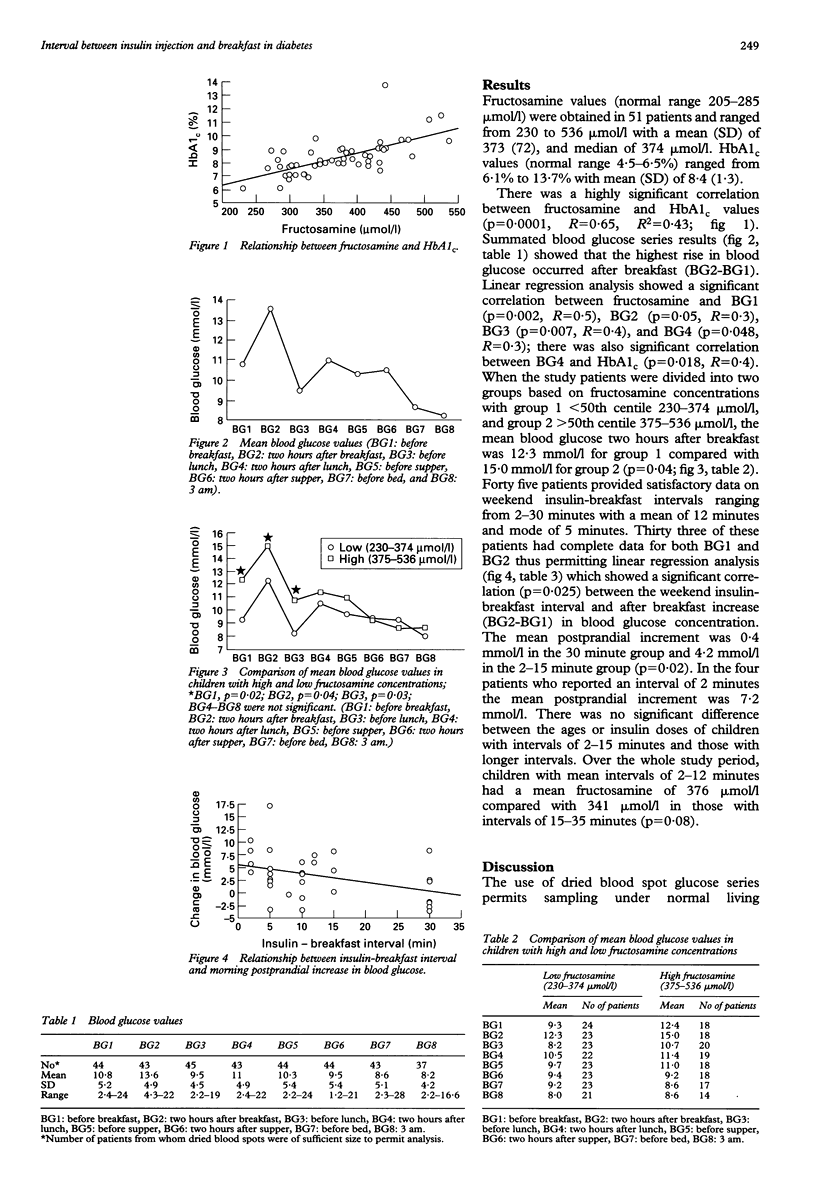Abstract
The relationship between the insulin-breakfast interval, postprandial increase in blood glucose, and glycaemic control was studied in 58 children with diabetes. Patients recorded insulin-breakfast intervals in a home diary over a seven day period, and during a 24 hour period at the weekend provided eight serial capillary dried blood spots for glucose analysis. The highest mean blood glucose value occurred two hours after breakfast and showed a significant correlation with fructosamine concentrations. Weekend insulin-breakfast intervals ranged from 2-30 minutes, with 70% reporting intervals of less than 15 minutes. There was a significant correlation between the weekend insulin-breakfast interval and the after breakfast increase in blood glucose with a mean increment of 0.4 mmol/l in the 30 minute group and 7.2 mmol/l in the 2 minute group. Over the whole study period, children with mean insulin-breakfast intervals of two to 12 minutes had a mean fructosamine concentration of 376 mumol/l compared with 341 mumol/l in those with intervals of 15-35 minutes. This study has shown that the interval between insulin injection and breakfast significantly influences the morning postprandial rise in blood glucose and consequently short term glycaemic control. It is therefore important that patients are encouraged to leave an interval of about 30 minutes between insulin injection and breakfast.
Full text
PDF


Selected References
These references are in PubMed. This may not be the complete list of references from this article.
- Heinemann L., Heise T., Jorgensen L. N., Starke A. A. Action profile of the rapid acting insulin analogue: human insulin B28Asp. Diabet Med. 1993 Jul;10(6):535–539. doi: 10.1111/j.1464-5491.1993.tb00116.x. [DOI] [PubMed] [Google Scholar]
- Kinmonth A. L., Baum J. D. Timing of pre-breakfast insulin injection and postprandial metabolic control in diabetic children. Br Med J. 1980 Mar 1;280(6214):604–606. doi: 10.1136/bmj.280.6214.604. [DOI] [PMC free article] [PubMed] [Google Scholar]
- Schleicher E., Wieland O. H. Protein glycation: measurement and clinical relevance. J Clin Chem Clin Biochem. 1989 Sep;27(9):577–587. [PubMed] [Google Scholar]
- Shield J. P., Baum J. D. Complications of diabetes in childhood. Diabet Med. 1993 Jul;10(6):499–502. doi: 10.1111/j.1464-5491.1993.tb00109.x. [DOI] [PubMed] [Google Scholar]
- Taylor R. P., Pennock C. A. A comparison of three methods for the estimation of capillary blood glucose in filter paper spots. Ann Clin Biochem. 1982 Jan;19(Pt 1):22–25. doi: 10.1177/000456328201900105. [DOI] [PubMed] [Google Scholar]
- Werther G. A., Jenkins P. A., Turner R. C., Baum J. D. Twenty-four-hour metabolic profiles in diabetic children receiving insulin injections once or twice daily. Br Med J. 1980 Aug 9;281(6237):414–418. doi: 10.1136/bmj.281.6237.414. [DOI] [PMC free article] [PubMed] [Google Scholar]
- Witt M. F., White N. H., Santiago J. V. Roles of site and timing of the morning insulin injection in type 1 diabetes. J Pediatr. 1983 Oct;103(4):528–533. doi: 10.1016/s0022-3476(83)80577-0. [DOI] [PubMed] [Google Scholar]


